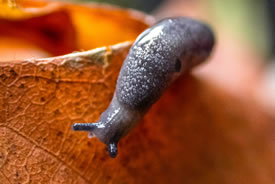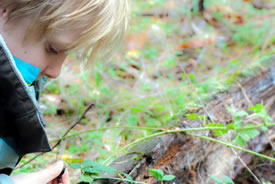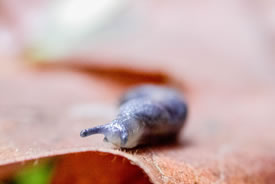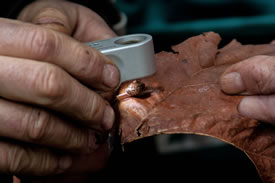Of bugs and slugs: Pint-sized citizen scientist discovers a strange blue slug, far from home

Blue-grey taildropper (Photo courtesy of Habitat Acquisition Trust)
My seven-year-old son Malcolm was excited about going on the Slug & Snail Walk at Chase Woods. He loves hiking, and I hadn’t the heart to tell him that there likely wouldn’t be a lot of actual hiking on this field trip. Slugs and snails move pretty slow, you see...
For me it was a work trip. I’m the Executive Director of Habitat Acquisition Trust, a small land trust that works on southern Vancouver Island. Kristiina Ovaska, a HAT biologist who specializes in terrestrial molluscs, was leading the walk (crawl?) with the Nature Conservancy of Canada's (NCC's) Kate Wilson. Kristiina had asked me to come along. I seldom get to share my work with my children, so after swimming lessons, Malcolm and I rushed over to the property.
Following a brief introduction, the group started off. After the first half-hour we’d travelled approximately 20 feet, exploring the forest floor as we went: every log, leaf pile, and old stump was examined for slugs, snails and the other small denizens of the forest floor. Malcolm was beginning to get frustrated — he wanted to hike. I managed to direct his energy to searching an old stump for slugs, buying me at least a few more minutes of time.
The call from Malcolm and Kristiina to "come over and look at this…" came at almost the same time. It turns out that each had independently discovered a small, slender bluish-grey slug about 2.5 cetimetres long: the blue-grey taildropper. Kristiina’s excitement was palpable — Malcolm’s too, even though he didn’t yet know the significance of his find.

On the hunt for slugs and snails at Chase Woods, BC (Photo courtesy of Habitat Acquisition Trust)
The value of the small and slimy
The name of the blue-grey taildropper tells you lot about the species. It’s a small slug, less than three centimetres long, blue to grey in colour, and it can autotomize (drop) its tail when threatened by a predator. While the predator, perhaps a beetle or carnivorous snail, is feasting on the lost — but still wriggling — tail, the taildropper makes a slow getaway.
When unthreatened, the taildropper spends its time foraging among fallen leaves for fungi. It seems to particularly like mycorrhizal fungi — a beneficial fungus that helps trees and other plants extract nutrients from the soil. The taildropper spreads the fungus’ spores through its scat.
Sadly, the blue-grey taildropper is endangered. It is only known to exist in about 10 locations in Canada, all on southern Vancouver Island. Its preferred habitat at the edges of stands of moss-draped maples and oak meadows in the Coastal Douglas-fir biogeoclimatic zone (say that 10 times fast!) on southeastern Vancouver Island has been largely converted into homes and roads.
For the slow-moving taildropper, a road is an impassable barrier, a house a mountain and a lawn an ocean. The known populations are small, and isolated by development. The discovery at Chase Woods is important for a number of reasons: it is the farthest north the species has ever been found and the first observation of blue-grey taildroppers in two years.
To the great benefit of the slug, the forest at Chase Woods is protected. The discovery of the blue-grey taildropper at this location can re-assure all of us that there is at least one more place where the blue-grey taildropper can contend with threats from beetles and snails, for which it is equipped, and not with bulldozers and chainsaws, for which it is not.

Blue-grey taildropper (Photo courtesy of Habitat Acquisition Trust)
Protect the habitat, and the species will follow
When the Nature Conservancy of Canada acquired Chase Woods they can’t have known about the blue-grey taildropper. Nevertheless, it’s not an accident that the species was protected there. The habitat at Chase Woods — the oak, maple and Douglas-fir forest falls from the cliffs of Mt Tzouhalem to the bottom of the Cowichan River Valley — is home to dozens of endangered and threatened species.
You may not see these species at risk, but they are there, living in last refugia of natural forest. Of course, biologists still want to know exactly which species are where — even in protected areas. Land managers can ensure that priority sites, such as the location of the blue-grey taildropper in Chase Woods, are kept free of invasive species, and that trails are not constructed through particularly sensitive areas.
Citizen science: Everyone can participate
The great thing about this process of discovery is that everyone can participate and make a significant contribution to conserving endangered species through citizen science. There are citizen science projects across the country working to understand and protect bears, bats, birds, butterflies and of course slugs.

Studying snails on Chase Woods (Photo courtesy of Habitat Acquisition Trust)
Discoveries such as this one help conservationists determine which properties are the most urgent to protect.
There are a range of benefits to citizen science: it is outdoors, in nature, and let me tell you it can be fulfilling. As fulfilling as the smile on a child’s face when you tell them they found a rare biological treasure few have ever seen. Just don’t mind the slime.


